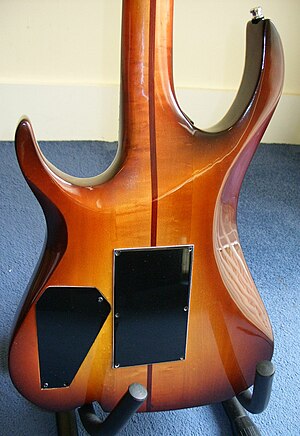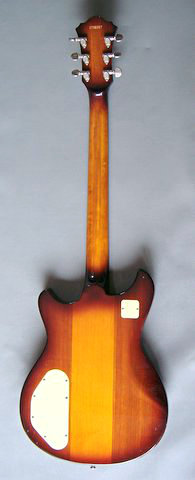Neck-through-body construction
This articlerelies largely or entirely on asingle source.(March 2011) |


Neck-through-body(commonlyneck-thruorneck-through) is a method ofelectric guitarconstruction that combines the instrument's neckand core of its body into a single unit. This may be made of a solid piece of wood, or two or more laminated together. The strings,nut,fretboard,pickupsandbridgeare all mounted on this central core. Additional body side components (if any) that fill-out its shape are glued or mechanically attached to this central core. These are referred to as "wings". The construction technique is also used on electricbass guitars.
Neck-through-body construction is considerably more expensive than the traditional gluedset-in neckandbolt-on neckstyle construction methods. However, it's less costly than the very rare and difficult "one-piece" fabrication out of an entire instrument fabricated out of a single piece of material.
History
[edit]The first electric bass guitar, the solid-body "Audiovox 736" created byPaul Tutmarccirca 1937, had a neck-through construction.
"The Log", a prototypesolid-body guitarbuilt byLes Paulin 1941, can be considered as a forerunner of neck-through designed instrument. Les Paul built the model using a recycled 4x4 fence post as the neck and body core, and mounted the disassembled parts of an Epiphone and Gibson archtop guitar onto it.

The 1952-57 Harmony H44 had this construction feature.
In 1956 Rickenbacker was one of the first guitar manufacturers to use the modern variant of this technique, although this was originally restricted exclusively to semi-hollowbody guitars.[1]
Pros and cons
[edit]The most important benefit for the player of a neck-thru guitar is the reduction of heel mass. Theheelis the term used to describe the thickened area of the end of the neck and/or body where the neck is attached to the body. Body-neck connection area thickening is required for structural integrity. In violins this area's called the "button", "saddle" or "nose".
The area where the neck attaches to the body is naturally a weak zone. There's a lot of pressure exerted on the instrument due to the combined tension of all the strings pulling on the instrument between thetunersand thebridge.The neck-body connection area is weaker if you have to join a separate neck to a body. The screws (bolt-on) or glue (set-neck) used to connect the neck to the body requires significant area to be able to provide sound structural integrity to act against the sting's tension and bond body to neck totally stably to ensure tuning stability of the instrument. Heel mass then becomes an obstacle when attempting to reach higher registers of thefretboard.
Neck-through construction allows easier access to higher frets because there is no need for a bulky heel as there is no neck-to-body connection. In such an instrument, the neckmorphsinto the body of such an instrument. When constructing a neck-through guitar the luthier canchamferthe neck-body transition area (which would be the heel) to a minimum, sometimes almost relieving the heel entirely. This allows easier, sometimes unhindered, access to the upper registers.
For players of rhythm oropen chordsalone, or players that do not reach up to the highest registers of the fretboard inleador solo playing, this benefit is very minimal and will still necessitate increased cost of the production method.
However, some opine that a neck-thru guitar sounds different to a bolt-on construction instrument. Many musicians[who?]assert that neck-through construction provides greater sustain, richer overtones and increased tuning stability inherent in the design when compared to abolt-onconstruction. As both ends of the guitar string are attached to the same piece of wood that runs the length of the instrument, more of the string's energy runs across the instrument, passing more of the string's harmonic content to the pickups in comparison with a bolt-on instrument.
Neck-through construction is significantly harder to mass-produce thanbolt-onorset-in neckconstructions and is primarily found on high-end guitars.[citation needed]It is somewhat more common inbassesthan in guitars.
Repairs to the neck are usually expensive and tedious. In many cases, it is usually easier to remove the old neck completely, either by taking the wings off and putting an entirely new core in, or by converting the guitar to abolt-onor set-neck by creating a heel and affi xing the new neck to the core already in place, rather than to try to repair the neck itself.[citation needed]However, thanks to excellent stability and reaction to string tension and pressure, neck-through guitars tend to be more sturdy.[citation needed]
Use
[edit]This structure is used by many companies, includingParker Guitars,BC Rich,Yamaha,Cort Guitars,Ibanez(primarily on basses),Jackson,Alembic,Schecter,Carvin,ESP Guitars,.strandberg*, Dean, Halo,Rickenbackerand many others.
Many configurations of theGibson FirebirdandThunderbirdare also built neck-through.
The construction method is also popular with independent guitar builders, who can typically devote more time to such a labour-intensive neck joint than a mass-producing company could.
References
[edit]- ^Rickenbacker International Corporation:The Modern Era of the Electric Guitar,retrieved 14 June 2012
